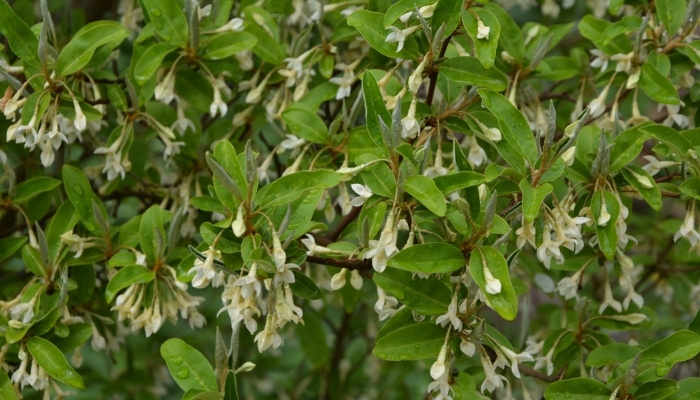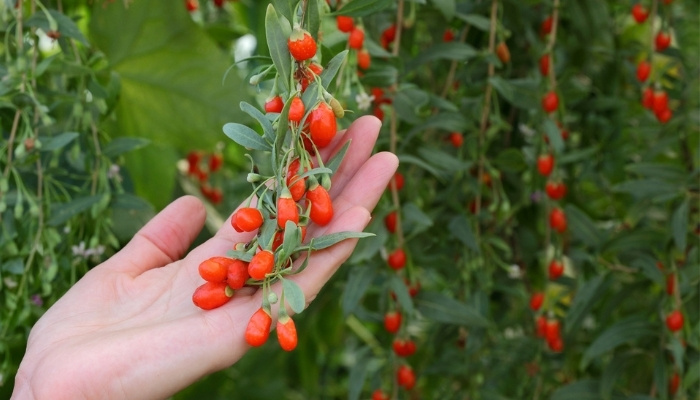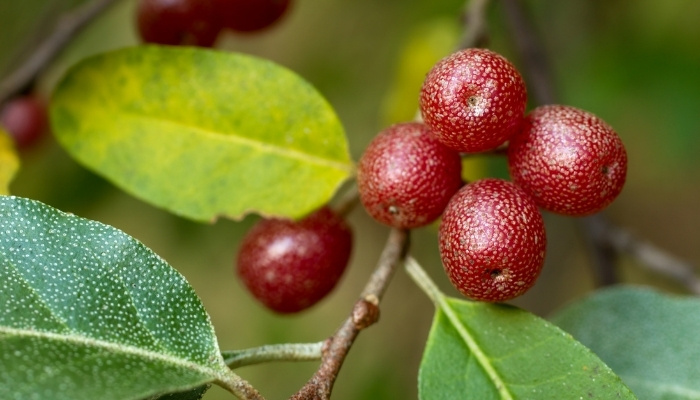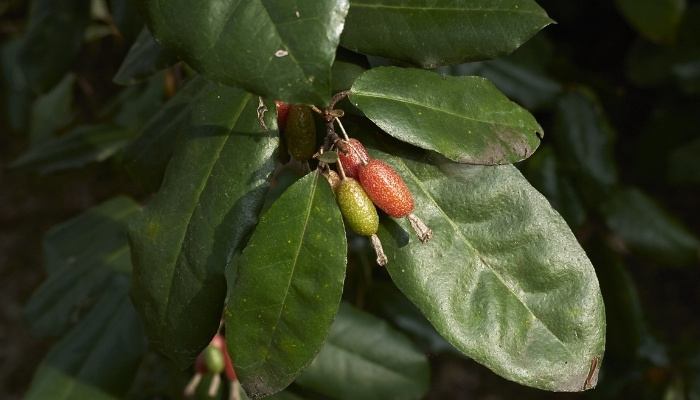Different shapes and flavors characterize berries. While some of them are indigenous to North America, others have been brought to the continent and successfully acclimated to its diverse growing environments.
Goumi berry is one of those plants that, although not well known, is gaining popularity rapidly thanks to its ornamental properties as well as its delicious fruits.
What is a goumi berry? Goumi berry is a perennial deciduous shrub that reaches 8 feet tall at maturity with shimmering green leaves and cream-colored flowers that look like bells. The fragrant flowers bloom in mid-spring. After pollination, cherry-like fruits develop that turn red with silver speckles when ripe.
Goumi berry as a fruiting shrub has a lot to offer to every garden and landscape. Read more to find out how to grow it successfully in your garden.
Goumi Berry Shrubs
Goumi berry (Elaeagnus multiflora) goes by many names. These include Cibie, Cherry Silverberry, Daio-Gumi, Longpipe Bush, and Cherry Elaeagnus among others. Its native habitat is east Asia, specifically Korea, China, and Japan. It’s ideal for Grow Zones 4 to 9.
Goumi Berry Shrub Appearance
As a deciduous perennial, goumi berry is a shrub that grows to about 8 feet tall at maturity. It has green leaves with a silver underside that shimmers in the sun.
The flowers are cream-colored and shaped like a bell. The flowers bloom in the early spring. In the fall, the shrub drops all the leaves and goes dormant.
Goumi Berry Shrub Native Region & Habitat
Goumi berry is native to east Asia. It can be found growing in Korea, Japan, and China. It has a high tolerance for poor growing conditions including poor soil, high and low pH levels, drought, and cold temperatures.
The roots of the bush can withstand temperatures as low as -20℉ without freezing over.
Goumi Berry Fruit Appearance & Size
The fruit of the goumi berry is oval and sometimes round. It averages one-third of an inch tall and 1 inch in diameter. When ripe, the berry turns red with silver speckles. The skin is too thin and damages easily, so you need to take extra care when harvesting the ripe fruits.
Are Goumi Berries Edible?
The fruits of the goumi berry are edible. They have a taste similar to rhubarb, both sweet and astringent. However, when fully ripe, they lose some of their tart taste. You can eat them either raw or cooked.
Are Goumi Berry Leaves & Seeds Edible?
The seeds of goumi berry are edible and can be consumed along with the fruits, either raw or cooked. Although the seeds are covered with a fibrous sheath, that doesn’t make consuming them a problem.
As for the leaves, they’re not edible. They’re too astringent and have no added flavors.
When Do Goumi Berry Shrubs Flower?
Goumi berry shrubs start to bloom in mid-spring. In warm regions, flowering might start as early as early spring. The flowers are bell shaped and grow to about a half inch in diameter.

How Tall Do Goumi Berry Shrubs Get?
Goumi berry shrubs reach about 8 feet tall and are the same in width. If that height is not manageable in your landscape, you’ll need to prune the shrub regularly to keep it in good shape.
How & When To Prune a Goumi Berry Shrub
The best time to prune goumi berry shrubs is when they’re dormant in the winter. Depending on the purpose of the shrub, your pruning techniques might vary.
For single accent shrubs, keep the middle of the canopy hollow. This creates inroads, improves ventilation, and allows plenty of sunlight into the middle of the shrub.
If you’re growing the shrub as a hedge plant, then trim the outer branches and the top of the canopy to create either a short or tall hedge.
The shrub tends to grow bushy, so regular trimming is required, especially for ornamental shrubs. Remove damaged or crossing branches as well as suckers during pruning.
Are Goumi Berry Shrubs Invasive?
Although other species in the same genus are considered invasive, goumi berry shrubs do not exhibit any invasive tendencies. With regular pruning, you can manage the shrub’s growth and prevent it from self-propagating through suckers.
When Do Goumi Berry Shrubs Produce Fruit?
Goumi berry shrubs are one of the earliest to fruit. The fruits often develop in early May. However, they’re not ready to harvest until July or August.
How & When To Harvest Goumi Berries
The longer the berries stay on the bush, the sweeter and less astringent they get. Although the fruits turn red in May, you should leave them until July or August to get the best taste and flavors out of them. You can tell that the fruit is ready for harvest when it turns dark red.
The skin of the ripe fruit is thin and fragile, so you need to handle them with care. Hold the ripe fruit in your hand and give it a gentle tug. It should come off the stem easily. If you meet resistance, that means the berry is not fully ripe yet.
Collect the harvested berries in a basket, ideally a hands-free option with a strap to allow you to use both hands for picking.
Can You Grow Goumi Berry Shrubs From Seed?
You can grow goumi berry shrubs from seed. However, it’s a tricky process since the seeds need both warm and cold processing to speed up their germination.
First, the seeds have to be kept in a warm place for 4 weeks. This is followed by cold stratification for 12 more weeks. Only then would the seeds germinate. See the video below to learn how easy it is to propagate this bush with cuttings.
Goumi Berry Shrub Garden Benefits
Goumi berry shrubs have many benefits in the garden. The shrub creates a symbiotic relationship with Frankia bacteria that absorbs the nitrogen in the atmosphere and enriches the soil with it.
The shrub is generally free from disease and requires little maintenance. It’s also easy to shape it and use it either as an accent bush or a hedge plant. The shimmering leaves and fragrant blooms give it excellent ornamental value.
Goumi Berry Health Benefits
The fruits of the goumi berry are rich in vitamins A and E. It contains high amounts of antioxidants that help reduce blood cholesterol and benefit the heart. In traditional medicine, the roots of the bush are boiled and the concoction is used to treat diarrhea and skin sores.
Ideal Growing Conditions for Goumi Berry Shrubs
To get the most of the goumi berry shrub both in ornamental values as well as fruits, make sure the soil is rich in nutrients and is quick to drain. Although the shrub is hardy to all kinds of soil and pH levels, the soil should be loamy to allow the roots to develop fast.
The shrub needs 6 to 8 hours of full sun every day in the spring and summer. The partial sun will not stunt the shrub’s growth, but it might impact the flowering and fruiting. Water the shrub once a week during the growing season with 1 inch of water. Factor in rainfall.
Goumi berry fixes nitrogen in the soil, but you still need to provide other nutrients such as phosphorus and potassium. Use a fertilizer low in nitrogen and apply it once every 2 to 3 weeks from early spring until harvest time.
Goumi Berry Look-Alikes
Goji Berry

Goji berry is another berry that is native to East Asia. It has many health benefits and can be added to many desserts.
Goji berry looks similar to goumi berry even in the red color of the ripe fruits, but goji berry has slightly more elongated and smaller berries, is more popular, and goes into many food supplements.
Autumn Olive

Autumn olive is a deciduous shrub that grows to about 11 feet tall. The fruits turn red when ripe and have a sweet and tart flavor.
The shrub is quite invasive, and there are local rules in different states regarding growing this shrub. It self-propagates through suckers and has a fast growth rate.
Silverthorn

Silverthorn grows to 23 feet tall with fragrant yellow flowers. It blooms in the fall and has small fruits that turn red when ripe. This bush is also invasive and tends to spread out fast, which poses a risk to the native flora in any given region.
Best Places To Buy Goumi Berry Shrubs
You can buy goumi berry shrubs online at places like Burnt Ridge Nursery, Raintree Nursery, and even Etsy. Most local nurseries in the US and Canada in Zones 4 to 8 will have the shrub as well.
Goumi Berry Recipe Ideas
You can always eat goumi berries fresh along with the seeds. They make for a quick snack full of nutrients. However, you can also cook the ripe berries. Goumi berry goes into many recipes from jelly to cakes and drinks.
You can make goumi syrup by boiling three portions of goumi berry with one portion of strawberries. Bring to a simmer, and let it cook for about an hour. Strain through a sieve to separate the pulp and stems, and add a sugary syrup for taste.
Conclusion
Goumi berry is a shrub with many ornamental values. The shrub can be grown as an accent plant or used in hedges. The blooms are fragrant, and the shrub bears red small fruits that can be consumed raw or cooked.
Just remember that pruning is an integral part of caring for the shrub since it tends to have a bushy growth habit.
